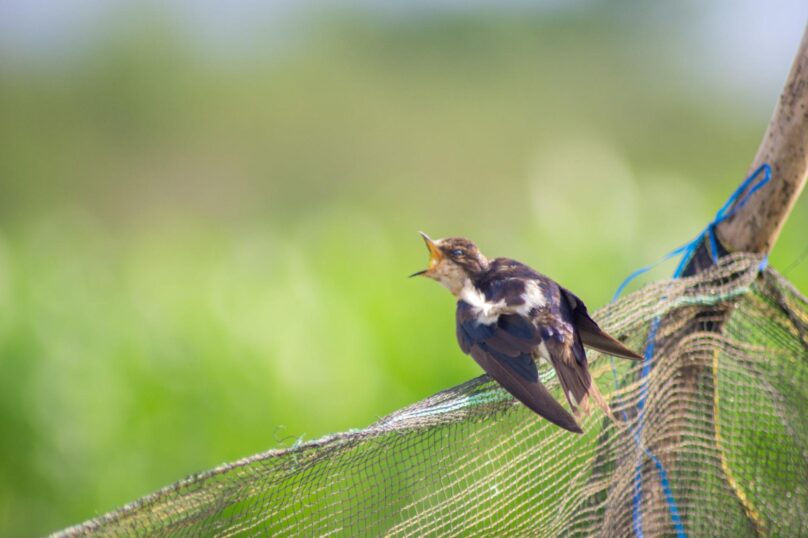
How Long Does Bird Netting Last? Durability and Maintenance Tips
Birds don’t ask permission to settle where they’re not welcome. Whether it’s a vineyard, warehouse, or rooftop, their presence quickly becomes costly. Bird droppings corrode surfaces, nesting creates blockages, and noise disrupts daily life. Bird netting offers a solid line of defense without harming the birds. But how long will it hold up before needing replacement?
What is Bird Netting and Why Do People Use it
Bird netting is a physical barrier designed to prevent birds from accessing spaces. It’s widely used in agriculture, commercial buildings, warehouses, and residential settings. The main goals are to prevent bird entry, protect property, and keep areas clean and safe. Choosing the right netting depends on where and how you plan to use it.
Purpose and Common Applications
Bird netting stops birds from nesting, roosting, or feeding in unwanted areas. In agriculture, it protects crops from birds that peck and damage fruit. Commercial and industrial buildings use it to block ledges, vents, and loading docks. Residential users often install it on balconies or rooftops to avoid bird mess. It works well when tailored to the specific structure and bird species.
Types of Bird Netting Materials
The three main types of bird netting materials are polyethylene, polypropylene, and steel. Polyethylene is the most popular due to its balance of cost and durability. Steel mesh lasts longer but is heavier and more expensive. UV-stabilized plastic nets resist sunlight damage and last longer outdoors. Coated nets offer protection against weather, dust, and bird waste buildup.
How Long Does Bird Netting Last?
Netting’s lifespan varies depending on the type, climate, and installation. On average, good-quality plastic netting lasts three to ten years. Steel mesh can stretch up to 15 years or more when properly installed. Environmental stress, bird activity, and upkeep significantly affect how long it stays effective.
Lifespan by Material Type
UV-stabilized polyethylene netting usually lasts around seven to ten years. Non-UV plastic netting may degrade after three to five years. If galvanized or coated, steel netting can last 15 years or more. Thicker mesh and tighter weaves resist tearing and sagging better. Always check the manufacturer’s durability claims against real-world use cases.
Factors That Affect Bird Netting Durability
Harsh sunlight can cause plastic netting to dry out and crack. Wind and rain wear down connection points, primarily if not properly anchored—locations near the ocean face salt corrosion, which reduces the net’s life. Birds may peck or claw at the netting, speeding up wear. Human contact, equipment, or machinery can also strain and tear sections.
Bird Netting Maintenance Tips
Good bird netting doesn’t just last because it’s made well. Maintenance matters just as much as material. A neglected net will fail faster than a budget one that’s well cared for. Regular upkeep protects your investment and ensures the net stays functional.
Cleaning and Inspection Routine
Check the netting every few months for signs of wear. Remove bird droppings, leaves, and other debris that build up over time. Dirt holds moisture, which can degrade the material. Inspect connection points to make sure nothing has come loose. Tighten sagging areas and clean with water or a gentle brush when needed.
Repairing Minor Damages Early
Small holes can quickly become a big problem if ignored. Use cable ties, netting clips, or repair kits to fix tears immediately and when the material stretches, and reinforce weak sections with extra support. Don’t wait until the whole structure starts sagging or birds get through. Quick fixes help keep the entire system working longer.
When to Replace Bird Netting
No net lasts forever, no matter how well you care for it. Knowing when to replace it can prevent bigger headaches. Old or damaged netting can stop doing its job and waste time and money. Watch for warning signs instead of waiting for failure.
Visible Wear and Structural Weakness
Look for holes, frayed edges, and sagging areas in the net. Sun-faded plastic often means the material is drying out and weakening. Cracks near anchor points usually signal material fatigue. Rust on steel netting is another clear red flag. Once these signs appear, the structure’s overall strength drops fast.
Decreased Effectiveness Over Time
Birds learn fast. Once they find a weak spot, they’ll keep coming back. If birds repeatedly get past the net, their effectiveness is compromised. Netting may loosen from its anchors due to wind or weight. A minor breach today could lead to full exposure tomorrow.
Choosing the Right Bird Netting for Long-Term Use
Picking the right net saves money and avoids stress. Every environment puts different pressure on your netting. A hot rooftop, humid greenhouse, or wind-blown warehouse will each wear down netting in unique ways. Material choice, weave type, and size all make a difference.

Material Selection Based on Environment
UV-protected polyethylene is ideal for both hot and sunny regions. In coastal areas, coated steel or marine-grade netting resists salt corrosion. Cold climates need flexible materials that don’t crack in freezing temperatures. Windy zones require heavy-duty anchor systems to prevent movement. Match the net to your weather before anything else.
Quality Over Cost in the Long Run
Cheaper bird netting may look fine initially, but it often fails early. Quality materials have better coatings, more substantial weaves, and tested durability. Some brands even offer warranties, which can reflect the actual lifespan. Paying more upfront often means spending less later. A single replacement can cost more than a long-lasting install.
Bird Netting Installation Matters More Than You Think
Even the best bird netting won’t hold up if installed poorly. Loose or uneven setups fail faster under stress. Tension, spacing, and framing all affect how long it lasts. A proper installation strengthens the net’s resistance to wind, pressure, and time.
Tension, Framing, and Anchoring Quality
The netting needs to be stretched tight but not overstrained. Proper tension keeps birds from pushing through and prevents sag. Use quality frames and steel cables instead of plastic ties for heavy-use areas. Anchors should be rust-proof and placed at close intervals. A strong frame makes the net a permanent part of the structure.
DIY vs. Professional Installation
Doing it yourself works for small areas like balconies or gardens. But larger setups need tools, skills, and knowledge. Mistakes like loose fitting or poor anchoring reduce durability. Professional bird proofing specialists know how to tailor the net to the space and species. Their work usually lasts longer and avoids costly do-overs.
How Climate Zones Impact Bird Netting Durability
Bird netting’s lifespan doesn’t depend solely on material or brand. Where it’s installed also affects its lifespan. Temperature swings, sunlight, and humidity all wear netting down differently. Choosing the right netting for your local climate can add years to its life.
Effects of Heat, Sunlight, and UV Exposure
Constant sun exposure dries out plastic netting over time. The material can become brittle, crack, or sag from UV damage. In hot climates like Arizona or Southern California, untreated netting often breaks down in three to five years. UV-stabilized polyethylene holds up better, resisting heat damage for up to ten years. Avoid transparent or light-colored netting outdoors, as it weakens faster than darker UV-blocking options.
Challenges in Wet, Humid, or Coastal Regions
Humidity promotes mildew and mold growth on untreated nets. Over time, the buildup weakens the fiber structure and stretches the mesh. In coastal zones, salt air corrodes metal anchors and frays plastic coatings. To offset this, use marine-grade hardware and mildew-resistant netting. Monthly rinsing with fresh water helps prevent salt buildup and extends netting strength in high-moisture areas.
Seasonal Maintenance Strategies for Bird Netting
Bird netting wears differently depending on the time of year. Heat, moisture, wind, and nesting patterns all stress the system. A single maintenance routine isn’t enough to handle changing conditions. Adjusting your care by season keeps the netting strong, safe, and reliable.
Spring and Summer Focus Areas
Spring marks peak nesting season, so early inspections are key. Check for damage left behind by winter—snow loads, fallen branches, or ice expansion. Tighten any sagging areas and patch holes before birds return. Heat makes plastic more brittle in summer, increasing the risk of cracks. Rinse off droppings regularly, as the acid weakens both mesh and anchors over time.
Fall and Winter Risk Management
Fall brings high winds that loosen fasteners and stretch connection points. Before storms hit, check anchor tightness and remove any debris weighing down the net. Winter’s cold causes some plastics to shrink or snap. If your region gets snow, use angled installations that let the buildup slide off. Store it in a dry space for removable netting to avoid off-season decay and mildew.
Pro Maintenance Hacks to Make Bird Netting Last Longer
Basic upkeep will keep bird netting functional, but professional techniques make it last. These hacks aren’t complicated; they’re just overlooked. They work best where downtime is costly, or access is limited. Add them to your routine, and you’ll cut long-term repair time by half.
Use Cable Tension Gauges and Corner Protectors
Overtightening netting can weaken it faster than birds ever will. Pros use cable tension gauges to keep the pressure consistent across the frame. This consistency stops unnecessary strain and keeps the net snug without snapping. Install rubber pads or corner guards at stress points like corners or bends. These reduce friction and prevent fraying over time, especially during windy seasons.
Rotate Netting Sections Annually
In large installations, some sections take more wear than others. Sun, wind, and dirt hit certain panels harder, depending on location. Rotate those sections once a year to spread wear more evenly across the system. Label them with small tags so you can track the shifts. It’s a small move that adds years to even mid-grade netting.

Make Bird Netting Last Longer With Smarter Moves
A stretched-out net sagging under pressure won’t stop a single bird. However, a system built with the right netting, properly installed, and regularly maintained holds strong year after year. It keeps birds out without a second thought and saves you from repeating the same battle every season. Bird netting isn’t just a barrier—it’s a quiet line of defense that only fails when you stop paying attention. Give it what it needs now, and it’ll protect what matters later.
Looking for real solutions that work? Visit the Elite Bird Management blog for expert tips, how-tos, and tools that keep your property bird-free




